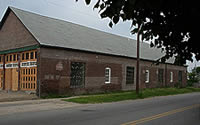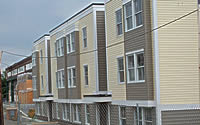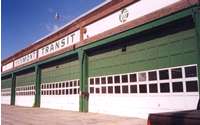Waste Site Cleanup & Reuse in New England
Development of the Vermont Bus Barns Property
|
Success in Brownfields Assessment Demonstration
Pilot Program
Burlington, VT
(July 5, 2001)
Contacts
The property at 343 North Winooski Avenue in Burlington, Vermont
(also known as the "Vermont Transit Bus Barns" property)
was successfully redeveloped as part of Burlington's work with the
EPA Brownfields Assessment Demonstration Pilot Program. In 1996
Burlington's
Community and Economic Development Office ![]() received $200,000 in funding from EPA's Brownfields Program. In
both 1998 and 2000, Burlington was recognized as a finalist in the
National Brownfields Showcase Communities competition and has received
a total of $300,000 in supplemental funding.
received $200,000 in funding from EPA's Brownfields Program. In
both 1998 and 2000, Burlington was recognized as a finalist in the
National Brownfields Showcase Communities competition and has received
a total of $300,000 in supplemental funding.
Work on the N. Winooski Avenue site commenced in fall of 1998.
Completion of the entire project is anticipated for September 2001.
It is a highly visible, "gateway property" to Burlington's
Old North End. This Enterprise
Community ![]() is the most densely populated and lowest income area of the city.
The property is 2.6 acres and had 40,000 square feet of enclosed
space. The site has been continuously in use as a transportation
center since 1885. In 1998, Burlington Rapid Transit Inc. owned
the site and leased it to Vermont Transit, which is now owned by
Greyhound. The facility engaged in routine activities such as oil
changing, coolant flushing, washing of buses and parts, tire repair,
is the most densely populated and lowest income area of the city.
The property is 2.6 acres and had 40,000 square feet of enclosed
space. The site has been continuously in use as a transportation
center since 1885. In 1998, Burlington Rapid Transit Inc. owned
the site and leased it to Vermont Transit, which is now owned by
Greyhound. The facility engaged in routine activities such as oil
changing, coolant flushing, washing of buses and parts, tire repair,
In 1999 Vermont Transit decided to relocate its operations and Burlington Rapid Transit Inc. sold the property to Burlington Community Land Trust (BCLT), a 501 (c)(3) non-profit development organization. BCLT controls the property in limited partnership with Housing Vermont as Bus Barns Housing Limited Partnership (BBHLP). BCLT also partnered with the city of Burlington as co-developer of the property. The Phase I environmental site assessment (ESA) was completed in fall of 1999 by ATC Associates and a full Phase II ESA was recommended. The assessments and development of the corrective action plan cost approximately $80,000. Using EPA Brownfields funds, Burlington paid $60,000 and BBHLP paid the balance. All remediation work has been and will continue to be paid for by BBHLP. Contaminants included asbestos, petroleum hydrocarbons, and a variety of compounds commonly associated with fleet maintenance and repair. Concrete slabs and the contaminated soil were removed from the site by SD Ireland. Ongoing work includes asbestos abatement, interior wall cleaning, and additional soil remediation.
The site had three principle structures; two historic brick barns and one steel-frame garage. The historic brick barns were renovated while the steel-frame garage was demolished to provide greenspace. One barn was converted into affordable apartments. Combined with a newly constructed building, 25 rental units of permanently affordable housing will be created. Burlington is currently experiencing an extreme housing shortage. In 2000, the rental vacancy rate was approximately 0.3%. Over the last 10 years, an average of only 32 new rental units per year have entered the market. The new housing at the Bus Barns site was fully funded by sources including Vermont Housing and Conservation Board, the city of Burlington, and Low-Income Housing and Historic Tax Credits.
The second brick barn was converted for commercial space. One occupant is the Good News Garage, which provides donated cars to low-income families for the cost of repairs only. The garage also includes a training program for low-income people interested in becoming mechanics. There are also several associated projects involving the Department of Public Works through a grant from the Metropolitan Planning Organization aimed at improving public safety though redesigning and improving the streets and sidewalks in the area, changing traffic flow at a dangerous intersection, and enacting traffic calming measures.






